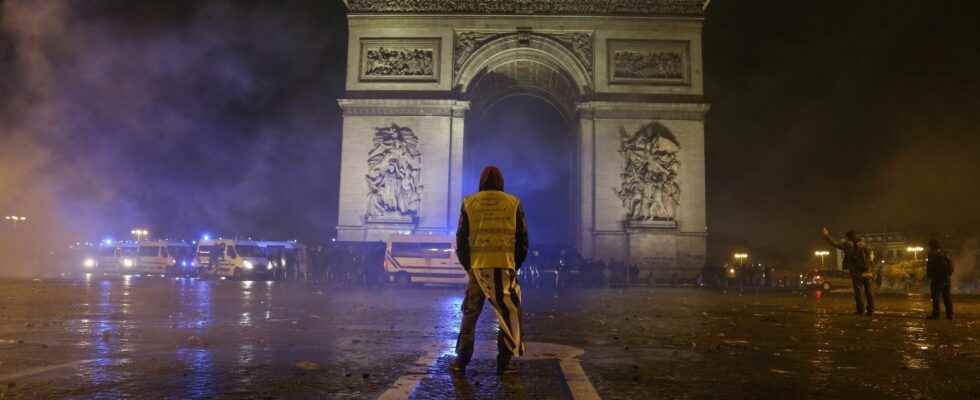It is a call to protest against pension reform, energy and fuel prices, or even inflation, launched on Facebook and relayed on social networks. This Saturday, January 7, “all the yellow vests” are expected in the capital and “everywhere in France” to relaunch the movement, in a social context conducive to tension. “This event is neither more nor less in line with those that have occurred every Saturday for four years”, explains Titouan Bisson, co-organizer of the event. On the dedicated Facebook page, only 650 people say they are “interested” for the time being. But the yellow vest wants to be reassuring: “On Twitter, the event turns enormously, with thousands of reactions. For us, the social movement and the general strike are the only ramparts against the neoliberal policy of the government.”
Are the yellow vests likely to be reborn, when the next few months should be marked by inflation at 7% – unheard of for forty years? For Christian Le Bart, professor of political science at Sciences Po Rennes and author of Little sociology of yellow vests, the probability that a new social movement will appear is significant. “If the yellow vests were a parenthesis that closed due to the lack of electoral or union outlets, the structural causes that saw it emerge are still present, and even multiplied”, develops-t -he. Claims linked to “purchasing power” and “inequality” reflect, according to him, “a fundamental dissatisfaction”, although factors exogenous to government policy – such as the war in Ukraine – also explain the situation.
“Whatever the cause, things are seen at the level of life experience, daily feelings. And when there is suffering, there is mobilization”, specifies the teacher. “Even if the context concerns all of Europe, social classes are not all affected in the same way. To put it another way, there are people who pay the bill more than others”, abounds Serge Paugam, sociologist and director of research at the CNRS, specialist in poverty.
A convergence of struggles
Like some 33,000 French bakers, for whom the increase in the price of electricity – which powers the ovens and cold rooms –, coupled with a sharp rise in the cost of raw materials, has threatened their activity. To help them, the Prime Minister, Elisabeth Borne, announced on January 3 the possibility of postponing the payment of their taxes and social security contributions, as well as of “spreading” the payment of energy bills “over the first months of the year. “.
But another subject is likely to soon take center stage: the pension reform project, the outline of which should be unveiled on January 10. “From the original movement of 2018, the yellow vests expressed their concern about the possibility of working longer. The difference with today is that the unions are also opposed to this measure, and that they are preparing to go to the streets. A convergence of struggles is therefore possible, and the mobilization could take on a certain scale”, analyzes Serge Paugam.
Same observation for Christian Le Bart, who considers that the advantage of the group of yellow vests is also its “openness”. “It’s a movement that comes from below, but at the same time very transversal from the point of view of the types of jobs represented. It goes against the current of French social history, where we marched rather as as employees or as civil servants”, he notes. Especially since the yellow vests still benefit from a “positive” image according to him, despite the violence that may have marred the movement: “The yellow vests continue to be associated with a provincial dimension, sincere, authentic. If the mobilizations unions do not take on the pension reform, it is possible that some of their members will join in.” On Twitter, several publications of collectives of yellow vests call on the unions to join the demonstrations of January 7. After three months of discussion with the government, the employee organizations are for the moment all united against the project.
For his part, Loïc Signor, spokesperson for Renaissance, does not wish to comment on “hypotheses”. “The yellow vests, like all French people, were invited to go to the polls last year. No offense to certain ‘figures’ of the movement, engaged in this campaign, the French have renewed their confidence in the president of the Republic,” he said. And to add: “You should never be afraid of the street, if the people who go down there do it in the rules. This has not always been the case with this movement of which we do not really know who is leading it or what in are the real demands”.
A mobilization different from 2018
One question remains: can we expect a situation completely identical to that of 2018? “At the time, there was an effect of surprise, which created popular fervor. If the movement lasted so long, it is also because the demands have evolved over time: we have gone from the price of fuel in the citizens’ initiative referendum. This characteristic will perhaps be partially represented, but there is still some uncertainty in the medium term”, Serge Paugam slices.
“The yellow vests are not an institution. Even if they draw on the same imagination, there is no organizational continuity with the 2018 movement. There is therefore no guarantee that we will be dealing with the same people”, adds meanwhile, Christian Le Bart. Among the former historical figures of the movement, Maxime Nicolle, also called Fly Rider, confirmed his presence, while calling for “a citizen putsch” to “recover sovereignty”, in a video published on January 5 on YouTube. “I think it’s a mistake to return to Paris, I kill myself saying it but no one listens to me. Discontent, it must be expressed in the regions”, judged for her part Jacline Mouraud, during an intervention on CNews on January 4.
